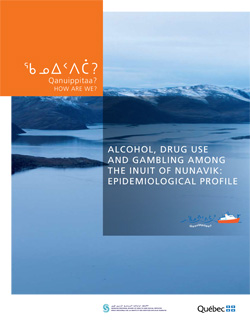Alcohol and drug use
The Nunavik Inuit Health Survey, conducted throughout the 14 communities of Nunavik in autumn 2004, provides an update of the alcohol and drug use descriptive profile of the population aged 15 and over and identifies the sociodemographic characteristics associated with substance use.
In Nunavik in 2004, the proportion of drinkers was 77%, which is lower than the rate observed in Canada and in Quebec. This rate, however, represents an increase of almost 17% in Nunavik compared with 1992. Globally, the prevalence of drinkers is higher among participants under the age of 45, who are more educated, who have a job and who live in a community that permits the sale of alcohol.
Heavy drinking (five drinks or more on a single occasion) is widespread in Nunavik with close to 9 out of 10 consumers having drunk heavily at least once in the year preceding the survey, a rate that is two times higher than that observed in southern Quebec and in Canada as a whole. Episodes of heavy drinking are also very frequent in Nunavik, with nearly a quarter of drinkers having five drinks or more on a single occasion on a weekly basis, a rate three times higher than that observed among Canadians in general and among Quebecers living in regions south of Nunavik.
The proportion of illicit drug users in the 12 months preceding the survey in Nunavik was 60%, more than four times higher than that observed in Canada, and rates of drug use have clearly increased over the past decade, for cannabis, cocaine and solvents.
Cannabis is by far the most commonly used drug in Nunavik. Although it is used by 8 or 9 males out of 10 aged 15 to 24, its use is also widespread among females, as well as in the overall population under the age of 45.
Gambling
The availability of gambling opportunities is associated with gambling activity and gambling activity is linked to the emergence of gambling problems. Frequent gambling activity and high wagers are directly associated with gambling problems. Research has shown that minorities, ethnic groups and socio-economically disadvantaged groups have greater rates of problem gambling.
On the whole, three out of five Inuit (60%) gambled in the year preceding the study. Women were proportionally more likely to gamble than men (67% vs. 53%). Instant lotteries (42%) and bingo (36%) were the two most popular games. Women (50%) play significantly more bingo than men (23%); women (46%) also gamble at instant lotteries more frequently than men (37%). On the other hand, men (27%) were more attracted to card/dice games than women (20%) and card/dice games were preferred by adults aged 18 to 29.
Fewer Inuit engaged in gambling on a yearly basis compared to people in southern Quebec, (Nunavik: 60%; Quebec: 81%). We observed no differences between the Inuit and southern Quebecers in terms of gambling on a weekly basis: 31% Inuit and 35% of southerners show that type of behaviour. However, 18-to-29-year-old Inuit (37%) were more likely to gamble than those in the same age group in the south (18%).
Inuit involved in gambling spent over $3300 yearly. Those playing card/dice games spent more than $4650 on that specific gambling activity and bingo players spent a yearly average of $1410 on bingo.
The level of gambling expenditures in Nunavik was considerably higher than those encountered in the south, where the yearly average was less than $900. When asked if they were spending too much time or too much money on gambling, 22% of Inuit gamblers responded in the affirmative. No difference was observed by gender, age or game.
Overall, fewer Nunavik Inuit gamble compared to the population in southern Quebec. Notwithstanding that general trend, certain games are more popular in Nunavik, including bingo and card/dice games, and involvement in gambling up north seems far greater than in the south, as underlined by the level of weekly play and also by the amounts wagered yearly.
The available data doesn’t allow us to directly determine the levels of problem gambling in Nunavik – no problem gambling scale was used in the present research. The behaviour of Inuit women in terms of gambling is also rather unusual compared to the results obtained among southern indigenous and minority populations: levels of participation are higher, weekly involvement is greater, and yearly spending is higher. These findings could lend support to the hypothesis that problem gambling is more prevalent among women in Nunavik communities.


